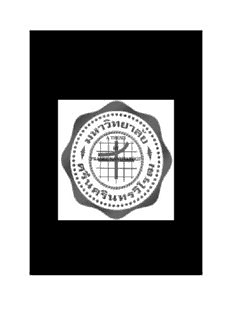Table Of ContentUSING COMMUNICATIVE ACTIVITIES TO DEVELOP ENGLISH SPEAKING ABILITY
OF MATTHAYOMSUKSA THREE STUDENTS
A THESIS
BY
PRANEE NANTHABOOT
Presented in Partial Fulfillment of the Requirements for the
Master of Arts Degree in Teaching English as a Foreign Language
at Srinakharinwirot University
June 2012
USING COMMUNICATIVE ACTIVITIES TO DEVELOP ENGLISH SPEAKING
ABILITY OF MATTHAYOMSUKSA THREE STUDENTS
A THESIS
BY
PRANEE NANTHABOOT
Presented in Partial Fulfillment of the Requirements for the
Master of Arts Degree in Teaching English as a Foreign Language
at Srinakharinwirot University
June 2012
Copyright 2012 by Srinakharinwirot University
USING COMMUNICATIVE ACTIVITIES TO DEVELOP ENGLISH SPEAKING
ABILITY OF MATTHAYOMSUKSA THREE STUDENTS
AN ABSTRACT
BY
PRANEE NANTHABOOT
Presented in Partial Fulfillment of the Requirements for the
Master of Arts Degree in Teaching English as a Foreign Language
at Srinakharinwirot University
June 2012
Pranee Nanthaboot. (2012). Using Communicative Activities to Develop English
Speaking Ability of Matthayomsuksa Three students. Thesis, M.A.
(Teaching English as a Foreign Language). Bangkok: Graduate School,
Srinakharinwirot University. Thesis Advisor: Dr. Somsak Khaewnuch.
The purpose of this study was to investigate the effect of communicative
activities to develop English speaking ability of Matthayomsuksa 3 students at
Watsantikaramwitthaya School, Ratchaburi. The participants were 30
Matthayomsuksa 3 students selected via random sampling. The students studied with
the researcher in a speaking classroom for seven weeks, in which the teacher used
various activities, such as describing and drawing pictures, mapping dialogues,
gapping information, playing jigsaws, and spotting the differences. The instruments
were five lesson plans, a pre-post speaking test, a teacher’s observation form, and a
students’ opinion form. The data from the speaking tests were analyzed using mean
scores, standard deviation scores, and t-test scores for dependent samples. The data
from the observation and opinion forms were analyzed using mean scores, standard
deviation scores.
The result of this study indicated that the students’ English speaking ability
after applying communicative activities was much higher than it used to be, with a
statistical significance at .05.
Keywords: Communicative Activities, English Speaking Ability
การใช้กิจกรรมทางภาษาเพื่อการสื่อสารเพื่อพัฒนาความสามารถด้านการพูดภาษาอังกฤษ
ของนักเรียนชั้นมัธยมศึกษาปีที่ 3
บทคัดย่อ
ของ
ปราณี นันทบุตร
เสนอต่อบัณฑิตวิทยาลัย มหาวิทยาลัยศรีนครินทรวิโรฒ เพื่อเป็นส่วนหนึ่งของการศึกษา
ตามหลักสูตรปริญญาศิลปศาสตรมหาบัณฑิต
สาขาการสอนภาษาอังกฤษในฐานะภาษาต่างประเทศ
มิถุนายน 2555
ปราณี นันทบุตร. (2555). การใช้กิจกรรมทางภาษาเพื่อการสื่อสาร เพื่อพัฒนาความสามารถด้าน
การพูดภาษาอังกฤษ ของนักเรียนชั้นมัธยมศึกษาปีที่ 3 ปริญญานิพนธ์ ศศม.
(การสอนภาษาอังกฤษในฐานะภาษาต่างประเทศ). กรุงเทพฯ: บัณฑิตวิทยาลัย
มหาวิทยาลัยศรีนครินทรวิโรฒ. อาจารย์ที่ปรึกษาปริญญานิพนธ์: ดร. สมศักดิ์ แก้วนุช.
การศึกษาครั้งนี้มีจุดมุ่งหมายเพื่อพัฒนาความสามารถการพูดภาษาอังกฤษเพื่อการ
สื่อสารของนักเรียนชั้นมัธยมศึกษาปีที่ 3 โรงเรียนวัดสันติการามวิทยา จังหวัดราชบุรี กลุ่มตัวอย่าง
ที่ใช้ในการทดลองเป็นนักเรียนชั้นมัธยมศึกษาปีที่ 3 จ านวน 30 คน โดยใช้วิธีการสุ่มตัวอย่างอย่าง
ง่าย ใช้เวลาในการทดลอง 7 สัปดาห์ ใช้กิจกรรมเพื่อการสื่อสารอย่างหลากหลาย เช่น กิจกรรมใช้
รูปภาพอธิบาย,กิจกรรมเติมบทสนทนาจากตัวชี้แนะ, กิจกรรมเติมข้อมูลให้สมบูรณ์,กิจกรรม
เชื่อมต่อข้อมูลกิจกรรมค้นหาความเหมือนและความแตกต่าง เครื่องมือที่ใช้ในการทดลอง และเก็บ
รวบรวมข้อมูล คือ แผนการจัดการเรียนรู้ จ านวน 5 แผน แบบทดสอบวัดความสามารถด้านการ
พูดภาษาอังกฤษ แบบสังเกตพฤติกรรมด้านการพูดภาษาอังกฤษ แบบแสดงความคิดเห็นต่อ
กิจกรรมภาษาเพื่อการสื่อสาร สถิติที่ใช้ในการวิเคราะห์ข้อมูลจากการทดสอบการพูดภาษาอังกฤษ
คือ ค่าเฉลี่ย ค่าเบี่ยงเบนมาตรฐาน และใช้สถิติ t-test แบบ Dependent Samples และข้อมูลสถิติ
ที่ใช้ในการวิเคราะห์จากแบบสังเกตพฤติกรรมด้านการพูดภาษาอังกฤษและแบบแสดงความ
คิดเห็นต่อกิจกรรมภาษาเพื่อการสื่อสาร คือ ค่าเฉลี่ย ค่าเบี่ยงเบนมาตรฐาน ผลการศึกษาพบว่า
ความสามารถด้านการพูดภาษาอังกฤษโดยใช้กิจกรรมทางภาษาเพื่อการสื่อสารของนักเรียนชั้น
มัธยมศึกษาปีที่ 3 หลังการทดลองสูงกว่าก่อนการทดลองอย่างมีนัยส าคัญทางสถิติที่ระดับ .05
The thesis titled
“Using Communicative Activities to Develop English Speaking Ability
of Matthayomsuksa Three Students”
by
Pranee Nanthaboot
has been approved by the Graduate School as partial fulfillment of the requirements
for the Master of Arts Degree in Teaching English as a Foreign Language of
Srinakharinwirot University
………………………… Dean of Graduate School
(Associate Professor Dr. Somchai Santiwatanakul)
June..…, 2012
Thesis Advisor: Oral Defense Committee:
…………………………..advisor …………………………...Chair
(Dr. Somsak Khaewnuch) (Dr. Anchalee Jansem)
..………………...……Committee
(Dr. Somsak Khaewnuch)
………………………Committee
(Dr. Apichai Rungruang)
ACKNOWLEDGEMENTS
The research was accomplished with the help of many people. First, I would
like to express my heartfelt gratitude to my thesis’s advisor, Dr. Somsak Khaewnuch,
for his kind consultation, invaluable advice, constant encouragement, and patience in
providing helpful comments. His guidance kept me alive throughout the ongoing
research. He gave me a lot of recommendations and invaluable feedback to my work.
In appreciation, my respectful heart goes out to him forever. Without him, this study
would not have been achieved.
Next, I would like to express my sincere appreciation and thanks to my
research committee Dr. Anchalee Jansem, and Dr. Apichai Rungruang for their
assistance, guidance, and most valuable comments.
My gratitude also goes to Mrs. Piyanard Sawangsak, Mrs. Kanchana Arnold,
and Mr. Nopadon Santhisiri for their guidance and insightful comments in developing
my research instruments.
Special thanks are given to Mr. Robin Zinger who sacrificed his valuable time
to edit drafts of my thesis.
My heartfelt thanks also go to all my teachers who gave me knowledge in my
life, and to the students at Watsantikaramwitthaya School who participated in this
study, and for their kind assistance, patience, and understanding.
Finally, I am especially indebted to my family for their understanding and
encouragement for me while I was studying at Srinakharinwirot University.
Pranee Nanthaboot
TABLE OF CONTENTS
Chapter Page
1 INTRODUCTION
Background…………………………………………………….…….……....1
Purpose of the Study……………………………………………………..…10
Significance of the Study…………………………………..………...……..10
Scope of the Study……………………………………………….…………10
Definition of Terms……………………………………….………..………11
Hypotheses……………………………………………….……...……....… 11
2 REVIEW OF RELATED LITERATURE
Communicative Language Teaching………………………..…...………….12
Principles of Communicative Approach………………….…………............14
Communicative Speaking………………………………….………….….…15
Components of Speaking…………………………………….………...…....16
Communicative Competence………………………………….…….…...….17
Stages of Teaching English for Communication……...…………….....……18
Failure of Teaching Speaking …………………..…………………….….....19
Problems with Speaking Abilities………………………………….……….20
Evaluating and Assessing English Speaking……………………..………....21
Rating Scales………………………….……………………………………..25
Related Literature on Communicative Activities………..…………………..29
TABLE OF CONTENTS (Continued)
Chapter Page
3 RESEARCH METHODOLOGY
Population and Participants………….……….………………………………37
Research Instruments………………………………….……………………..38
Data Collection……………………………..………………………..………43
Data Analysis……………………………..…………….…………………....43
4 FINDINGS…………………………………………………...……..……….....….45
5 CONCLUSION AND DISCUSSION……………………..…...……………...…54
REFERENCES………………………………………………..….……..…….…..61
APPENDICES…………………………………………..………...………...……..70
APPENDIX A English Speaking Test………………………..………………….71
APPENDIX B The three rater’s scores in English speaking test……….….……73
APPENDIX C English Speaking Rating Sheet………………………………….76
APPENDIX D English Speaking Ability Evaluation……………………….…..79
APPENDIX E Item Objective Congruence (IOC)………………………………81
APPENDIX F Speaking Observation Form……………………………..…...….85
APPENDIX G Students’ Opinion Form…………………..………………..……87
APPENDIX H Lesson Plan………………………………...……………………91
APPENDIX I Classroom Environment………………………………………….96
Description:Keywords: Communicative Activities, English Speaking Ability . to use English language in communication, learning and understanding the culture .. 2000). The learners' attention is focused on the ideas communicated, not on the.

